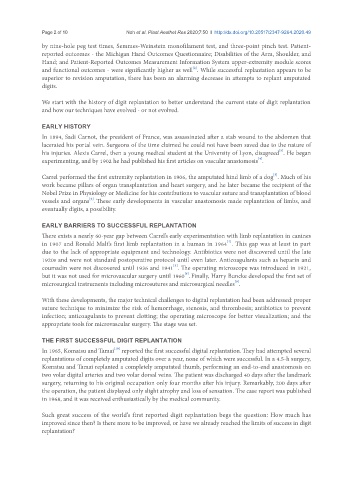Page 576 - Read Online
P. 576
Page 2 of 10 Noh et al. Plast Aesthet Res 2020;7:50 I http://dx.doi.org/10.20517/2347-9264.2020.49
by nine-hole peg test times, Semmes-Weinstein monofilament test, and three-point pinch test. Patient-
reported outcomes - the Michigan Hand Outcomes Questionnaire; Disabilities of the Arm, Shoulder, and
Hand; and Patient-Reported Outcomes Measurement Information System upper-extremity module scores
[2]
and functional outcomes - were significantly higher as well . While successful replantation appears to be
superior to revision amputation, there has been an alarming decrease in attempts to replant amputated
digits.
We start with the history of digit replantation to better understand the current state of digit replantation
and how our techniques have evolved - or not evolved.
EARLY HISTORY
In 1894, Sadi Carnot, the president of France, was assassinated after a stab wound to the abdomen that
lacerated his portal vein. Surgeons of the time claimed he could not have been saved due to the nature of
[3]
his injuries. Alexis Carrel, then a young medical student at the University of Lyon, disagreed . He began
[4]
experimenting, and by 1902 he had published his first articles on vascular anastomosis .
[5]
Carrel performed the first extremity replantation in 1906, the amputated hind limb of a dog . Much of his
work became pillars of organ transplantation and heart surgery, and he later became the recipient of the
Nobel Prize in Physiology or Medicine for his contributions to vascular suture and transplantation of blood
[6]
vessels and organs . These early developments in vascular anastomosis made replantation of limbs, and
eventually digits, a possibility.
EARLY BARRIERS TO SUCCESSFUL REPLANTATION
There exists a nearly 60-year gap between Carrel’s early experimentation with limb replantation in canines
[7]
in 1907 and Ronald Malt’s first limb replantation in a human in 1964 . This gap was at least in part
due to the lack of appropriate equipment and technology. Antibiotics were not discovered until the late
1920s and were not standard postoperative protocol until even later. Anticoagulants such as heparin and
[5]
coumadin were not discovered until 1936 and 1941 . The operating microscope was introduced in 1921,
[8]
but it was not used for microvascular surgery until 1960 .Finally, Harry Buncke developed the first set of
[9]
microsurgical instruments including microsutures and microsurgical needles .
With these developments, the major technical challenges to digital replantation had been addressed: proper
suture technique to minimize the risk of hemorrhage, stenosis, and thrombosis; antibiotics to prevent
infection; anticoagulants to prevent clotting; the operating microscope for better visualization; and the
appropriate tools for microvascular surgery. The stage was set.
THE FIRST SUCCESSFUL DIGIT REPLANTATION
[10]
In 1965, Komatsu and Tamai reported the first successful digital replantation.They had attempted several
replantations of completely amputated digits over a year, none of which were successful. In a 4.5-h surgery,
Komatsu and Tamai replanted a completely amputated thumb, performing an end-to-end anastomosis on
two volar digital arteries and two volar dorsal veins. The patient was discharged 40 days after the landmark
surgery, returning to his original occupation only four months after his injury. Remarkably, 200 days after
the operation, the patient displayed only slight atrophy and loss of sensation. The case report was published
in 1968, and it was received enthusiastically by the medical community.
Such great success of the world’s first reported digit replantation begs the question: How much has
improved since then? Is there more to be improved, or have we already reached the limits of success in digit
replantation?

